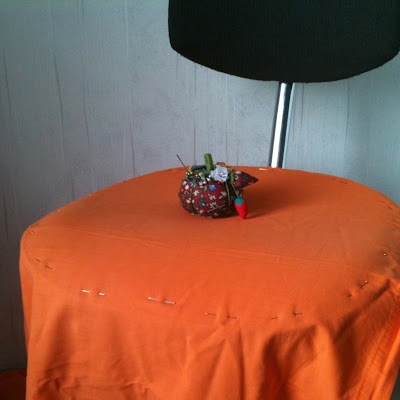Drafting a pattern for this chair was not difficult, because I could stick pins into its upholstery to first copy the pattern with fabric, then transfer that to paper. This is basically the essence of what needs to be done.
#2 Copying then drafting the pattern
First, find a suitable fabric for the copying stage that you don't mind scribbling all over, cutting up then throwing away. No-stretch is essential, cotton would be ideal. An old bed sheet for example is quite perfect for this.
Pin it around the edge of the seat, make sure it's smooth but not stretched, and watch the straight grain to be straight, so your pattern pieces won't become skewed or stretched left or right. It's also good to iron the fabric (which I have not paid attention to do...alas) so excess millimeters in the creases won't distort your pattern.
After pinning, draw around the stitching line where the seat top joins the seat edges. Cut along this line - the cutting line should be just where the stitching line is in the chair upholstery.
Do the same around the chair sides too; pin at the top and at the base, if necessary turning the chair over. When you encounter seams anywhere along the process, like I did on each side and then at the back, make
sure you cut and start a new pattern piece there. This way you will end up with a sewing pattern that will construct exactly how the original upholstery does.
Once the seat is copied, move on to copy the backrest. With a measuring tape or by eyeballing it, find the exact middle on the top and bottom of the back of the backrest - mark along these centre points with pins. Pin your fabric onto the backrest starting from this straight line - which will become a centre back seam in your pattern piece. Repeat the same pin-draw-cut process as on the seat (you only need to do the one side here).
Next, pin-draw-cut your fabric onto the front of the backrest too, not forgetting to mark the centre points, which should match up exactly with the centre points on the back. It's good to leave on the ready pieces as you progress, to see what you have and haven't done yet, as well as to check if your seams will reach together ok.
Always mark centre points (where later the paper pattern piece can be symmetrically folded); also on large pieces especially with curved seams, mark referral or any joining points on both joining pattern pieces: these will become your notches on the paper pattern, without which it's hard to match up long or curved seams.
Also mark which pattern piece is for which part of the chair. (I wrote S for seat, and BR F for backrest front, for example.)
When you are done with copying - ie. your whole chair is covered in copying fabric - and your seam lines match and your markings are complete, you can unpin the fabric pieces.
Next take some measurements of the chair: measure the middle lengths between centre points, accross widths, and any other helpful parameters that will aid your drafting the paper patterns. Note these measurements down on a guide for yourself.
You should then check these measurements against your fabric pattern pieces - if something is off, pin the trouble piece back on the chair and investigate where the mistake is until the chair measurements match the fabric pattern piece measurements.
Once you are happy with this, take some pattern paper, a ruler, a pencil and some pins.
Pin the fabric pattern pieces to the paper - again check the straightness of your grainline and make sure you are not stretching the fabric.
Draw with pencil around the fabric shapes along the marked seam lines. Now transfer all your markings (centre marks, notches, any other info) to your paper patterns. Once you are done with transferring all the fabric shapes and their markings onto paper, time for small adjustments.
Just make sure that all your sewing lines are neat and clean. If the pattern piece is symmetrical, fold it in half along the centre marks and make sure that both sides are the same, if not, make corrections until the two halves are exactly the same. Then measure your paper pattern piece against your chair measurements, until it all matches up. It takes a little time but this way you will have a very good paper pattern for your chair that will fit it like a glove when sewn up.
As a last job, add your seam allowance! (I sew at a 1cm seam allowance, but you add as much as you need or are used to.) You need to add seam allowance on every edge where the pattern piece is being joined to another.
At this point, you can wipe your brow because the sewing pattern is ready! Believe me it's worth putting in some time and attention to contra-check measurements, sewing lines and markings now, because sewing will be easy and problem-free, and your chair cover will look great.
There's one more part to show you how to make up the cover, but next Monday I will post an update on my quilting project instead - to give you a break from this chair and to give you time to chew through this long post if you need it!















Love this! Now come do my computer chair in white? :D My white cat is always on my black chair, makes me want to give in and just re-cover it.
ReplyDeletehaha! thanks Van, it'd be fun to leave the house with a suitcase and just say "I'm off to the US of A to do some of my mock-upholstering. See ya!" :)
Delete